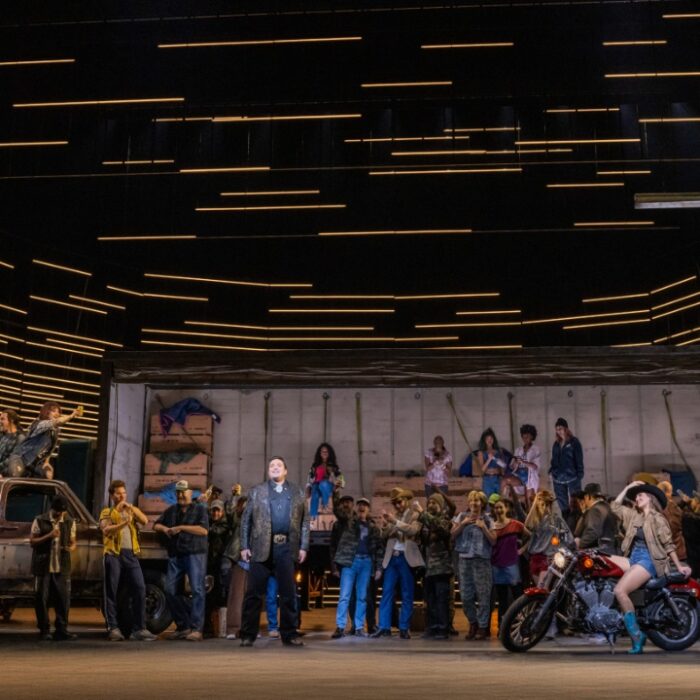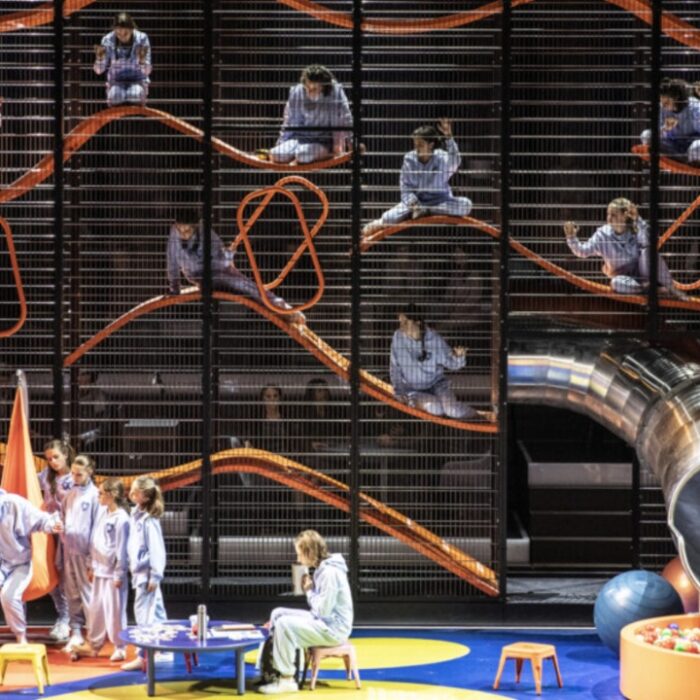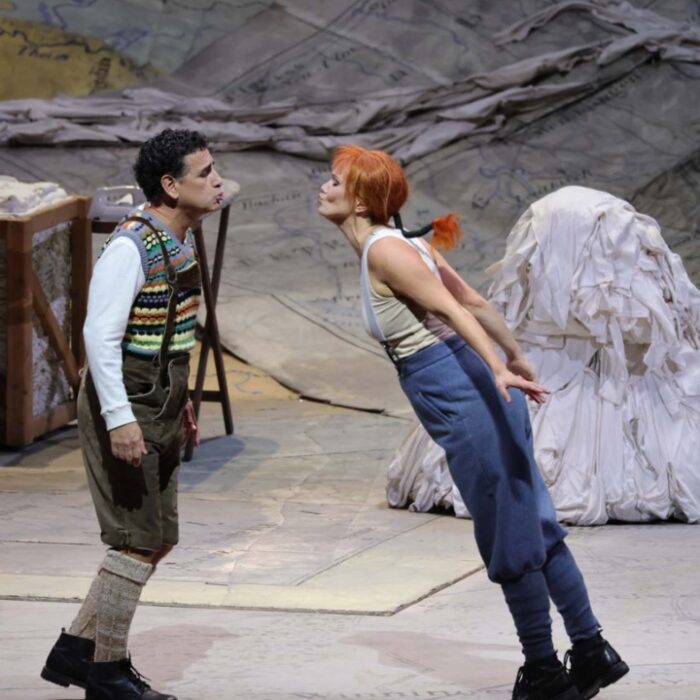
Rossini Opera Festival 2025 Review: Soirées musicales / La cambiale di matrimonio
Performance of Meticulous Philological Work Illuminates ROF’s role as a True Laboratory of Research and Rediscovery of Rossini’s Legacy
By Bernardo Gaitan(Photo: Amati Bacciardi / ROF 2025)
Soirées musicales
After the triumph of his last opera, “Guillaume Tell,” Gioachino Rossini decided to abandon theatrical composition and retire to his home in Paris to recover from nervous exhaustion. Even so, he never stopped writing music: he composed for himself, for Olympe Pélissier–whom he married in 1846 after the death of Isabella Colbran–and for his circle of friends. Despite his illness, Rossini remained active, devoting himself both to sacred and secular music. Among the latter stands the “Soirées musicales:” a collection of twelve songs written between 1830 and 1835 and published that same year. Eight are set to poems by the Italian exile Carlo Pepoli, a frequent guest at Rossini’s Parisian salon, and four to texts by Pietro Metastasio.
As a prologue to a double bill in 2025, the Rossini Opera Festival (ROF) offered the “Soirées musicales” in the acoustically perfect Teatro Rossini in Pesaro as a refined first-part, or Prologue, or “musical aperitif.” Originally conceived for voice and piano, the songs were presented in chamber-orchestra arrangements thanks to Fabio Maestri’s clever instrumentation, which successfully highlighted the colors and nuances originally conceived for the keyboard.
Performed in concert form with the beautiful curtain closed, the program unfolded into an hour of music alternating between “La promessa,” “Il rimprovero,” “La partenza,” “L’orgia,” “L’invito,” “La pastorella delle Alpi,” “La gita in gondola,” and the celebrated tarantella “La danza” (curiously sung here by soprano), alongside the nocturnes “La regata veneziana,” “La pesca,” and “La serenata,” culminating in the moving duet “Li marinari.”
The protagonists were four young artists from the Accademia Rossiniana: soprano Vittoriana De Amicis, refined and elegant in her musicianship, with brilliant high notes though at times unclear in diction; tenor Paolo Nevi, a promising voice still in development, with slight difficulty in the passaggio but compensating perfectly with charisma, pleasant high notes, and excellent articulation. In the duets, the mezzo-soprano Andrea Niño impressed with her resonant and beautiful low register in “La regata veneziana,” while baritone Gurgen Baveyan closed the concert with vigor in “Li marinari.” Warm applause for the four soloists paved the way for the second part of the evening.
La cambiale di matrimonio
In the second half of the evening, the ROF presented a revival of “La cambiale di matrimonio,” Rossini’s very first opera, composed in 1810 when the young composer was only eighteen. For the 2025 edition, the one-act farce was staged in the critical edition by Eleonora Di Cintio, who restored passages traditionally cut and rediscovered pages, including Edoardo’s aria “Calma mio bene i palpiti d’un barbaro dolor” and a dialogue with Fannì recently found in a manuscript. This meticulous philological work reaffirms the Festival’s role as a true laboratory of research and rediscovery of Rossini’s legacy.
On the podium of the Filarmonica Gioachino Rossini for both programs was Christopher Franklin, who conducted with clear tempi, brilliant rhythms, and a thoroughly Rossinian style. He paid special attention to Rossini’s agogic markings, giving breadth to phrasing and carefully shaping the dynamics of the score. Particularly excellent were the recitatives, accompanied on fortepiano by maestro Giulio Zappa, who–as is his trademark–added vitality to the dialogues through his undeniable bel canto sensibility and absolute command of the keyboard. He even delighted the audience with a charming Entr’acte, harmonizing some of the musical themes on the harpsichord to cover a scene change. The orchestra, despite some fragilities in the strings and horns, delivered with precision from the Sinfonia onward– later reused and expanded by Rossini for Adelaide di Borgogna.
Laurence Dale’s witty and playful staging, with lively sets and refined costumes by Gary McCann, placed the action in a delightful British setting. The façade and interior of a typical nineteenth-century English house immediately evoked the visual atmospheres of Wes Anderson’s The Grand Budapest Hotel and George Cukor’s My Fair Lady, revealing interiors of wood paneling, colorful tapestries, and spaces in constant transformation: from kitchen to parlor, from Mill’s bedroom to the nocturnal finale among trees and fog. The British tenor, now as stage director, succeeded in creating a production brimming with irony and visual detail, where the striking costumes alluded to Tobia Mill’s profession as a merchant of exotic fabrics. In contrast, Slook and his servant arrived from Canada clad in furs and rustic attire, accompanied by an unexpected companion: a huge brown bear (masterfully animated by Matteo Anselmi), a comic and surreal element that both frightened the characters and delighted the audience, eventually becoming an integral part of the plot.
The cast proved decisive for the evening’s success. Festival veteran and one of today’s foremost bel canto voices, Pietro Spagnoli, delivered an exemplary Tobia Mill. A buffo interpreter of true distinction: flawless sillabato, theatrical phrasing, enviable dynamic control, and commanding vocal presence. His secure, ringing, and resonant high notes, coupled with undeniable vis comica, turned the role into a character at once believable and irresistible. Alongside him, Mattia Olivieri portrayed a memorable Slook: athletic and youthful, with a resonant and supple baritone, he captivated the audience through genuine and charismatic acting. His cavatina “Donne belle, donne care” shone, as did the final duet with Spagnoli, for which both were rewarded with ovations celebrating their musical and theatrical mastery.
Paola Leoci offered a sparkling Fannì with agile vocalism and clean coloratura. Though her stage characterization carried less force compared to her male colleagues, she was warmly applauded in the aria “Vorrei spiegarvi il giubilo” where her vocal agility stood out. American tenor Jack Swanson brought to life a stylish, slightly caricatured Edoardo Milfort, limited by a modestly developed role but convincingly sketched with his light, refined timbre in duets with Fannì. Baritone Ramiro Maturana, as Norton, displayed comic flair and good taste, while soprano Inés Lorans charmed as Clarina, especially in her delightful aria di sorbetto: “Anch’io son giovane.”
This production, conceived in 2020 during the pandemic and later toured as far as Oman in 2022, has only gained solidity with time: clever stage direction, refined sets, a high-caliber cast, and vibrant conducting brought back to life this Rossinian gem. With its compact one-hour-and-twenty-minute duration, this revival preserved all the freshness of a light yet satirical comedy, thrilling the audience who responded with generous applause for the entire cast, reserving especially enthusiastic ovations for Spagnoli and Olivieri.



